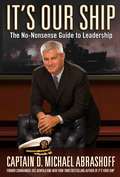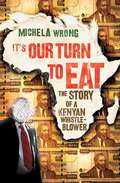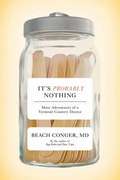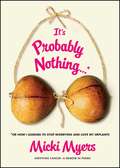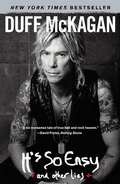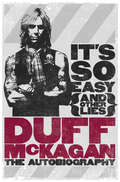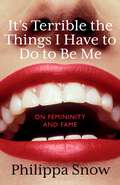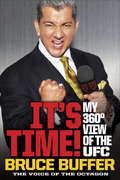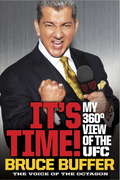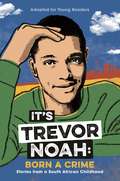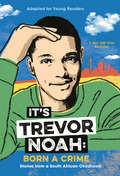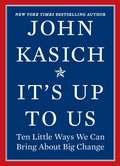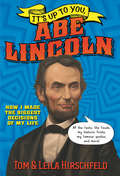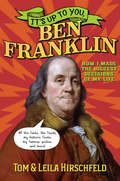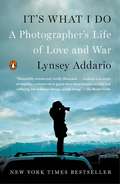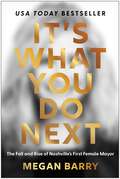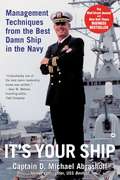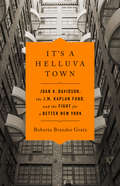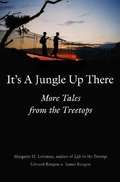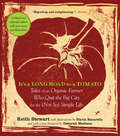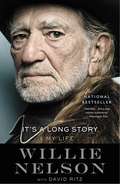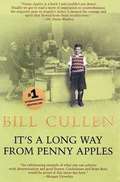- Table View
- List View
It's Our Ship: The No-Nonsense Guide to Leadership
by Captain D. AbrashoffCaptain D. Michael Abrashoff, legendary commander of the USS Benfold, continues in the same vein of his bestselling book IT'S YOUR SHIP with the knowledge he's gained from his speaking to and advising some of the top business minds in the world. The story of Captain Abrashoff and his command of USS Benfold has become legendary inside and outside the Navy. By governing his ship with his unique management techniques, Abrashoff turned the Benfold into a model of naval efficiency, with amazing cost savings, the highest gunnery score in the Pacific Fleet, and a highly motivated and top performing crew. In IT'S YOUR SHIP, he first demonstrated how to bring his successful management techniques from the ship to the boardroom. Now, in his newest book IT'S OUR SHIP, in the same rugged, can-do voice, Abrashoff will focus on the leadership, motivational, and management insights and tips that he has learned from his last six years of addressing business and corporate audiences. Abrashoff's timely advice will be eminently prescriptive, and will feature anecdotes and insights from leaders of businesses large and small and from public and non-profit sectors.
It's Our Turn to Eat: The Story of a Kenyan Whistle-Blower
by Michela WrongThe true story of one man&’s fight against corruption: "like a John Le Carré novel&” that shows &“how and why Kenya descended into political violence&” (Washington Post). In January 2003, Kenya was hailed as a model of democracy after the peaceful election of President Mwai Kibaki. By appointing respected longtime reformer John Githongo as anticorruption czar, the new Kikuyu government signaled its determination to end the shady practices that had tainted the previous regime. Yet only two years later, Githongo himself was on the run, having secretly compiled evidence of official malfeasance throughout the new administration. Unable to remain silent, Githongo, at great personal risk, made the painful choice to go public. The result was a Kenyan Watergate. Michela Wrong&’s account of how a pillar of the establishment turned whistle-blower—instantly becoming one of the most hated and admired men in Kenya—grips like a political thriller while probing the very roots of the nation&’s predicament.&“A fast-paced political thriller. . . . Wrong&’s gripping, thoughtful book stands as both a tribute to Githongo&’s courage and a cautionary tale.&” —New York Times Book Review
It's Probably Nothing
by Beach CongerIt's Probably Nothing continues the tale woven by Dr. Beach Conger in his first book, Bag Balm and Duct Tape. This new collection sees Conger and his wife yearning for new challenges and relocating to the suburbs of Philadelphia after 25 years in mythical Dumster, Vermont. Conger gamely takes a job in a teaching hospital in the poorest part of the city and gets to experience urban bureaucratized medicine and its trials-a far cry from the more idiosyncratic and hands-on version he practiced in Vermont. After 5 years Conger and his wife move back to Dumster, where he rediscovers more about his patients' capacity to both cope and cherish one another than he expected. Each of the tightly constructed chapters is centered around a particular patient or particular theme in medicine. It's Probably Nothing is both funny and poignant, and showcases both Conger's irreverent view into medicine and his profound empathy for the characters he encounters along the way. His experience highlights how medicine-and problems with our current medical system-can remain the same and yet be vastly different across class, race, and region. Among the people the reader meets are urban drag queens, small-town farmers and other heroes, Vermont celebrities, and the occasional reclusive author.
It's Probably Nothing...*
by Micki MyersDaring, sly, and unlike any other book you've read, this memoir-in-poems tackles cancer with a bawdy wit guaranteed to make you laugh your wig off.As a vibrant woman in her early forties, mother of two, poet, artist, and teacher, Micki Myers decided to confront her cancer diagnosis head on with the sharpest tools in her arsenal: namely, her sense of humor and unbridled poetic license. The result is a charming, poignant, laugh-out-loud collection that hits all the highs (morphine) and lows (everything else) of being a cancer patient and surviving with your spirit intact (even if your boobs are not). It's Probably Nothing... is the perfect gift for a friend in crisis, providing laughter, wisdom, and much-needed perspective. From losing your hair (even, ahem, down there) and gaining two bouncy silicone strangers, to the pitfalls of marijuana therapy and the endless chemo-room muzak "that makes you think/survival might be overrrated," Myers reminds you that you're not alone and that it's okay to laugh.
It's So Easy
by Duff MckaganA founding member of Guns N' Roses and Velvet Revolver shares the story of his rise to the pinnacle of fame and fortune, his struggles with alcoholism and drug addiction, his personal crash and burn, and his phoenix-like transformation via a unique path to sobriety. In 1984, at the age of twenty, Duff McKagan left his native Seattle--partly to pursue music but mainly to get away from a host of heroin overdoses then decimating his closest group of friends in the local punk scene. In L.A. only a few weeks and still living in his car, he answered a want ad for a bass player placed by someone who identified himself only as "Slash." Soon after, the most dangerous band in the world was born. Guns N' Roses went on to sell more than 100 million albums worldwide. In It's So Easy, Duff recounts GN'R's unlikely trajectory to a string of multiplatinum albums, sold-out stadium concerts, and global acclaim. But that kind of glory can take its toll, and it did--ultimately--on Duff, as well as on the band itself. As GN'R began to splinter, Duff felt that he himself was done, too. But his near death as a direct result of alcoholism proved to be his watershed, the turning point that led to his unique path to sobriety and the unexpected choices he has made for himself since. In a voice that is as honest as it is indelibly his own, Duff--one of rock's smartest and most articulate personalities--takes readers on his harrowing journey through the dark heart of one of the most notorious bands in rock-and-roll history and out the other side.
It's So Easy
by Duff MckaganIn his New York Times bestseller, Duff McKagan, founding member of Guns N' Roses and Velvet Revolver, shares the story of his rise to fame and fortune, his struggles with alcoholism and drug addiction, his personal crash and burn, and his life-saving transformation via a unique path to sobriety.In 1984, at the age of twenty, Duff McKagan left his native Seattle--partly to pursue music but mainly to get away from a host of heroin overdoses then decimating his closest group of friends in the local punk scene. In LA only a few weeks and still living in his car, he answered a want ad for a bass player placed by someone who identified himself only as "Slash." Soon after, the most dangerous band in the world was born. Guns N' Roses went on to sell more than 100 million albums worldwide. In It's So Easy, Duff recounts Guns' unlikely trajectory to a string of multiplatinum albums, sold-out stadium concerts, and global acclaim. But that kind of glory can take its toll, and it did--ultimately--on Duff, as well as on the band itself. As Guns began to splinter, Duff felt that he himself was done, too. But his near death as a direct result of alcoholism proved to be his watershed, the turning point that sent him on a unique path to sobriety and the unexpected choices he has made for himself since. In a voice that is as honest as it is indelibly his own, Duff--one of rock's smartest and most articulate personalities--takes readers on a harrowing journey through the dark heart of one of the most notorious bands in rock-and-roll history and out the other side.
It's So Easy (and other lies): The Autobiography
by Duff McKaganExplosive autobiography of Guns N' Roses and Velvet Revolver bass guitarist Duff McKaganDuff McKagan was a co-founder of Guns N' Roses, with a 13-year tenure on bass in what was at the time the biggest band on earth. As well as pulling together the classic line-up (Slash on guitar, Steven Adler on drums, rhythm guitarist Izzy Stradlin and vocalist Axl Rose), Duff was the unofficial musical director of the band and the most experienced musician, and played bass, drums and guitar, as well as co-writing many of the songs. Over the years, Guns N' Roses have broken many records in rock history - APPETITE FOR DESTRUCTION is the most successful debut album in the history of recorded music; the band's 1991 records, USE YOUR ILLUSION parts 1 and 2, debuted at one and two on the album charts, a feat never achieve before or since; and their 28-month ILLUSION world tour is still the longest running concert tour in history.Duff charts the rise of the group, and his own fall, as with success came heavy drinking and drug use, culminating in his hospitalisation for acute pancreatitis in 1994. Forced to sober up, Duff started taking an interest in business, eventually completing a degree in economics and making a killing on the stock market. He has since worked with Slash in another band, Velvet Revolver, and has continued to play with various artists over the last 15 years.IT'S SO EASY (AND OTHER LIES) is the explosive memoir of a great rock musician who, against the odds, has lived to tell the tale.
It's So Easy: and other lies
by Duff MckaganIn his New York Times bestseller, Duff McKagan, founding member of Guns N' Roses and Velvet Revolver, shares the story of his rise to fame and fortune, his struggles with alcoholism and drug addiction, his personal crash and burn, and his life-saving transformation via a unique path to sobriety.In 1984, at the age of twenty, Duff McKagan left his native Seattle--partly to pursue music but mainly to get away from a host of heroin overdoses then decimating his closest group of friends in the local punk scene. In LA only a few weeks and still living in his car, he answered a want ad for a bass player placed by someone who identified himself only as "Slash." Soon after, the most dangerous band in the world was born. Guns N' Roses went on to sell more than 100 million albums worldwide. In It's So Easy, Duff recounts Guns' unlikely trajectory to a string of multiplatinum albums, sold-out stadium concerts, and global acclaim. But that kind of glory can take its toll, and it did--ultimately--on Duff, as well as on the band itself. As Guns began to splinter, Duff felt that he himself was done, too. But his near death as a direct result of alcoholism proved to be his watershed, the turning point that sent him on a unique path to sobriety and the unexpected choices he has made for himself since. In a voice that is as honest as it is indelibly his own, Duff--one of rock's smartest and most articulate personalities--takes readers on a harrowing journey through the dark heart of one of the most notorious bands in rock-and-roll history and out the other side.
It's Terrible the Things I Have to Do to Be Me: 'A brutal and brilliant study of female celebrity' Megan Nolan, Telegraph
by Philippa Snow'Turns female celebrity inside-out. One of the most enjoyable books of the year' Nicole Flattery, author of Show Them A Good Time'A brutal and brilliant study of female celebrity ... a joy to read, fizzing with intelligence' Megan Nolan, Telegraph---------------------------------------------------------------------------------------How does an icon become an icon? How did Anna Nicole Smith model herself on Marilyn Monroe? What connects Lindsay Lohan with Elizabeth Taylor? How is self-made beauty Pamela Anderson like trans bond girl Caroline 'Tula' Cossey?In a series of interconnected essays about pairs of famous women, award-nominated essayist and art critic Philippa Snow explores the echoes and connections between a constellation of female stars and lays bare the artful and gruelling demands of femininity - from the golden age of Hollywood to the Instagram era. Full of the fascinating, entertaining and lurid details you might expect from the lives of mega-famous celebrities, dissected with icicle-sharp intelligence and rendered in stylish, flamboyant prose, Philippa Snow's first full-length non-fiction work is a radically insightful book about the complex meanings and layers of femininity in a male-dominated world.
It's Terrible the Things I Have to Do to Be Me: 'A brutal and brilliant study of female celebrity' Megan Nolan, Telegraph
by Philippa Snow'Turns female celebrity inside-out. One of the most enjoyable books of the year' Nicole Flattery, author of Show Them A Good Time'A brutal and brilliant study of female celebrity ... a joy to read, fizzing with intelligence' Megan Nolan, Telegraph---------------------------------------------------------------------------------------How does an icon become an icon? How did Anna Nicole Smith model herself on Marilyn Monroe? What connects Lindsay Lohan with Elizabeth Taylor? How is self-made beauty Pamela Anderson like trans bond girl Caroline 'Tula' Cossey?In a series of interconnected essays about pairs of famous women, award-nominated essayist and art critic Philippa Snow explores the echoes and connections between a constellation of female stars and lays bare the artful and gruelling demands of femininity - from the golden age of Hollywood to the Instagram era. Full of the fascinating, entertaining and lurid details you might expect from the lives of mega-famous celebrities, dissected with icicle-sharp intelligence and rendered in stylish, flamboyant prose, Philippa Snow's first full-length non-fiction work is a radically insightful book about the complex meanings and layers of femininity in a male-dominated world.
It's Time!
by Bruce BufferIf you're reading these words, chances are that you, like me, are a fan of the great sport we call MMA. And if you're a fan, then you probably recognize my face. Yeah, that's right--I'm that guy you see at every UFC match, spinning around and roaring into the microphone and getting up in fighters' grills. Okay, so I might not be the most subtle or refined announcer in the business. But I hope I communicate my passion for the sport in a way no other announcer does. I'll say it again: Passion. Because that's what this book is about. In these pages, I want to tell you about the passion that first led me to bet everything on this sport of ours, way back when MMA was outlawed in half the country and there wasn't a dime to be made on it. I want to tell you how that passion all started, with my larger-than-life father, a former Marine Drill Sergeant who, by the time I was ten, had taught me to play poker and blackjack, field-strip a Luger pistol blindfolded, and recite poetry. He was a man who thought nothing of confronting a group of thugs armed with nothing but his fists--and who expected the same strength and honor from his sons. I want to take you inside the incredible brotherhood that makes up the UFC as nobody ever has before, to tell you about the bond we all share and the crazy times I've had over the years with guys like Randy Couture, Tito Ortiz, Chuck Liddell, BJ Penn, and Jon "Bones" Jones. I want to give you my Octagon-side insights on many of the big fights you remember, and just maybe, to tell you about a few memorable fights that took place outside of the octagon, too--from my own sparring match with a youngster named Royce Gracie back before the phrase "Mixed Martial Arts" even existed, to some other brawls you might've heard about. And I want to tell you about the remarkable, late-life meeting with the celebrity brother I never knew I had--a brother whose existence my parents had never once breathed a word about!--that helped inspire me to chase my own dreams of standing up in the Octagon. Surprising stuff from the guy in the fancy tux, right? And that's just the start. There's a lot you don't know about me yet. And now... IT'S TIME! I told you.
It's Time!: My 360-Degree View of the UFC
by Bruce BufferIf you're reading these words, chances are that you, like me, are a fan of the great sport we call MMA. And if you're a fan, then you probably recognize my face. Yeah, that's right-I'm that guy you see at every UFC match, spinning around and roaring into the microphone and getting up in fighters' grills. Okay, so I might not be the most subtle or refined announcer in the business. But I hope I communicate my passion for the sport in a way no other announcer does. I'll say it again: Passion. Because that's what this book is about. In these pages, I want to tell you about the passion that first led me to bet everything on this sport of ours, way back when MMA was outlawed in half the country and there wasn't a dime to be made on it. I want to tell you how that passion all started, with my larger-than-life father, a former Marine Drill Sergeant who, by the time I was ten, had taught me to play poker and blackjack, field-strip a Luger pistol blindfolded, and recite poetry. He was a man who thought nothing of confronting a group of thugs armed with nothing but his fists-and who expected the same strength and honor from his sons. I want to take you inside the incredible brotherhood that makes up the UFC as nobody ever has before, to tell you about the bond we all share and the crazy times I've had over the years with guys like Randy Couture, Tito Ortiz, Chuck Liddell, BJ Penn, and Jon "Bones" Jones. I want to give you my Octagon-side insights on many of the big fights you remember, and just maybe, to tell you about a few memorable fights that took place outside of the octagon, too-from my own sparring match with a youngster named Royce Gracie back before the phrase "Mixed Martial Arts" even existed, to some other brawls you might've heard about. And I want to tell you about the remarkable, late-life meeting with the celebrity brother I never knew I had-a brother whose existence my parents had never once breathed a word about!-that helped inspire me to chase my own dreams of standing up in the Octagon. Surprising stuff from the guy in the fancy tux, right? And that's just the start. There's a lot you don't know about me yet. And now... IT'S TIME! I told you.
It's Trevor Noah: (YA edition)
by Trevor NoahADAPTED FOR YOUNG READERSThe host of The Daily Show, Trevor Noah, tells the story of growing up mixed race in South Africa under and after apartheid in this young readers' adaptation of his bestselling adult memoir Born a Crime: Stories from a South African Childhood.BORN A CRIME IS SOON TO BE A MAJOR MOTION PICTURE STARRING OSCAR-WINNER LUPITA NYONG'O!Trevor Noah, host ofThe Daily Show, shares his remarkable story of growing up in South Africa, with a black South African mother and a white European father at a time when it was against the law for a mixed-race child like him to exist. But he did exist -- and from the beginning, the often-misbehaved Trevor used his keen smarts and humour to navigate a harsh life under a racist government. This compelling memoir blends drama, comedy and tragedy to depict the day-to-day trials that turned a boy into a young man. In a country where racism barred blacks from social, educational, and economic opportunity, Trevor surmounted staggering obstacles and created a promising future for himself, thanks to his mom's unwavering love and indomitable will.It's Trevor Noah: Born a Crime not only provides a fascinating and honest perspective on South Africa's racial history, but it will also astound and inspire young readers looking to improve their own lives.
It's Trevor Noah: Stories from a South African Childhood (Adapted for Young Readers)
by Trevor NoahThe host of The Daily Show, Trevor Noah, tells the story of growing up half black, half white in South Africa under and after apartheid in this young readers' adaptation of his bestselling adult memoir Born a Crime: Stories from a South African Childhood. <p><p>Trevor Noah, the funny guy who hosts The Daily Show, shares his remarkable story of growing up in South Africa, with a black South African mother and a white European father at a time when it was against the law for a mixed-race child like him to exist. <p><p>But he did exist--and from the beginning, the often-misbehaved Trevor used his keen smarts and humor to navigate a harsh life under a racist government. <p><p>This compelling memoir blends drama, comedy, and tragedy to depict the day-to-day trials that turned a boy into a young man. In a country where racism barred blacks from social, educational, and economic opportunity, Trevor surmounted staggering obstacles and created a promising future for himself, thanks to his mom's unwavering love and indomitable will. <p><p>It's Trevor Noah: Born a Crime not only provides a fascinating and honest perspective on South Africa's racial history, but it will also astound and inspire young readers looking to improve their own lives. <P><b>A New York Times Bestseller</b>
It's Up to Us: Ten Little Ways We Can Bring About Big Change
by John KasichA Little Book about Big ChangeWe all want the same things. We want to live a life of purpose and meaning. We want to leave a legacy for our children and grandchildren. We want to leave the world a better place. And yet we spend so much time wringing our hands over what’s wrong and not nearly enough time fixing those things within our control.John Kasich has walked the corridors of power both in the politics, as a former leader of Congress, governor of Ohio, presidential candidate, and in the private sector, as an in-demand public speaker, best-selling author and a strategic advisor to businesses and large non-profits. Yet he’s seen that the most powerful movements have started from the bottom up. Rather than waiting on Washington, the solutions happen once we become leaders in our own lives and communities. The strength and resilience of our nation lies in each of us. That’s what this book is about.In It’s Up to Us, Kasich shares the ten little ways we each can bring about big change. Taken together, they chart a path for each to follow as we look to live a life bigger than ourselves. Taken one-by-one, they can help to lift us from a place of outrage or complacency or helplessness and move us closer to our shared American dream.
It's Up to You, Abe Lincoln (It's Up to You)
by Leila Hirschfeld Tom HirschfeldHistory gets hilarious in this interactive Abraham Lincoln biography that will have readers laughing while they learn. Perfect for readers of Nathan Hale's Hazardous Tales.Abraham Lincoln was one of the greatest presidents of all time. But what did it take to rise from frontier poverty? To lead his country through the Civil War? To alter the course of history forever?Father-daughter team Tom and Leila Hirschfeld's tongue-in-cheek biography explores ten crucial decisions in one amazing life. With over one hundred pieces of archival and original art, fun facts, sidebars, historical trivia, and more, this book follows Abe's footsteps through the close calls that defined his leadership and shaped America as we know it today."Be a best friend and give this book to someone who has not read it." -Kirkus, Starred review
It's Up to You, Ben Franklin: How I Made The Biggest Decisions Of My Life (It's Up to You)
by Leila Hirschfeld Tom HirschfeldHistory meets humor in this interactive Benjamin Franklin biography. Laugh and learn as this American hero make the toughest choices of his life. Perfect for readers of Nathan Hale's Hazardous Tales.You're Benjamin Franklin: inventor, humorist, diplomat-spy, and Founding Father. To rise from humble beginnings and become an American hero, you have to weigh the facts, trust your gut, and make tough choices that will forge America's destiny. No pressure!In this tongue-in-cheek biography, father-daughter team Tom and Leila Hirschfeld explore eleven critical decisions that shaped Ben's incredible life. With over 100 pieces of archival and original art, fun facts, historical trivia, sidebars, and more, follow Ben's footsteps through the smart calls and near misses that launched his career and helped unite the United States!
It's What I Do
by Lynsey Addario"A brutally real and unrelentingly raw memoir."--Kirkus (starred review)War photographer Lynsey Addario's memoir It's What I Do is the story of how the relentless pursuit of truth, in virtually every major theater of war in the twenty-first century, has shaped her life. What she does, with clarity, beauty, and candor, is to document, often in their most extreme moments, the complex lives of others. It's her work, but it's much more than that: it's her singular calling.Lynsey Addario was just finding her way as a young photographer when September 11 changed the world. One of the few photojournalists with experience in Afghanistan, she gets the call to return and cover the American invasion. She makes a decision she would often find herself making--not to stay home, not to lead a quiet or predictable life, but to set out across the world, face the chaos of crisis, and make a name for herself.Addario finds a way to travel with a purpose. She photographs the Afghan people before and after the Taliban reign, the civilian casualties and misunderstood insurgents of the Iraq War, as well as the burned villages and countless dead in Darfur. She exposes a culture of violence against women in the Congo and tells the riveting story of her headline-making kidnapping by pro-Qaddafi forces in the Libyan civil war.Addario takes bravery for granted but she is not fearless. She uses her fear and it creates empathy; it is that feeling, that empathy, that is essential to her work. We see this clearly on display as she interviews rape victims in the Congo, or photographs a fallen soldier with whom she had been embedded in Iraq, or documents the tragic lives of starving Somali children. Lynsey takes us there and we begin to understand how getting to the hard truth trumps fear.As a woman photojournalist determined to be taken as seriously as her male peers, Addario fights her way into a boys' club of a profession. Rather than choose between her personal life and her career, Addario learns to strike a necessary balance. In the man who will become her husband, she finds at last a real love to complement her work, not take away from it, and as a new mother, she gains an all the more intensely personal understanding of the fragility of life.Watching uprisings unfold and people fight to the death for their freedom, Addario understands she is documenting not only news but also the fate of society. It's What I Do is more than just a snapshot of life on the front lines; it is witness to the human cost of war.
It's What You Do Next: The Fall and Rise of Nashville's First Female Mayor
by Megan BarryUSA Today Bestseller At some point, all of us will be at our worst, and while some of us will be remembered for it, none of us should be defined by it. In 2015, after a historic run-off election, Megan Barry became the first female mayor of Nashville, Tennessee. Quickly becoming one of the most popular progressive politicians in the Bible Belt, Barry was a beloved leader with a sky-high approval rating and an unshakable hope for a new, forward-thinking, modern South. For her first few years in office, she was one of the most important voices at the table. Until she became the most notorious. Barry loved three things the most in the world—her son, Max, her husband, Bruce, and her job as the mayor of Nashville . . . until she lost two of them. Her monumental lapse in judgment led to a painful public reckoning and the fall of her rising political career. A battle with substance-use disorder robbed her of her only child. Grief, pride, shame, longing, and resentment nearly destroyed her marriage. Barry has to start again, the right way, with humility, hope, and a wicked sense of humor. It&’s What You Do Next is a deeply honest book about womanhood at home, in politics, and in the spaces between. It&’s about moving forward after we&’ve fallen short, finding the grace to love, and to love oneself again. It&’s about the aching world of grief and the light beyond it. Warm, funny, and uncompromisingly honest, Barry speaks to women as their close friend, not their fearless leader, her true self, not always her best self. She gives readers permission to come as they are and leave knowing that what matters most, is what happens next.
It's Your Ship: Management Techniques from the Best Damn Ship in the Navy
by Captain D. Michael AbrashoffThe legendary New York Times bestselling tale of top-down change for anyone trying to navigate today's uncertain business seas. When Captain Abrashoff took over as commander of USS Benfold, it was like a business that had all the latest technology but only some of the productivity. Knowing that responsibility for improving performance rested with him, he realized he had to improve his own leadership skills before he could improve his ship. Within months, he created a crew of confident and inspired problem-solvers eager to take the initiative and responsibility for their actions. The slogan on board became "It's your ship," and Benfold was soon recognized far and wide as a model of naval efficiency. How did Abrashoff do it? Against the backdrop of today's United States Navy, Abrashoff shares his secrets of successful management including: See the ship through the eyes of the crew: By soliciting a sailor's suggestions, Abrashoff drastically reduced tedious chores that provided little additional value. Communicate, communicate, communicate: The more Abrashoff communicated the plan, the better the crew's performance. His crew eventually started calling him "Megaphone Mike," since they heard from him so often. Create discipline by focusing on purpose: Discipline skyrocketed when Abrashoff's crew believed that what they were doing was important. Listen aggressively: After learning that many sailors wanted to use the GI Bill, Abrashoff brought a test official aboard the ship-and held the SATs forty miles off the Iraqi coast. From achieving amazing cost savings to winning the highest gunnery score in the Pacific Fleet, Captain Abrashoff's extraordinary campaign sent shock waves through the U.S. Navy. It can help you change the course of your ship, no matter where your business battles are fought.
It's a Helluva Town: Joan K. Davidson, the J.M. Kaplan Fund, and the Fight for a Better New York
by Roberta Brandes GratzA history of the J.M. Kaplan Fund and its role in shaping New York City, from World War II to the present.The J.M. Kaplan Fund was established in 1945 by Jacob M. Kaplan, and would go on to play a critical role in New York City's cultural and urban life. Kaplan's long leadership of the Fund (1945-1977) was marked by determined advocacy, including the effort to save Carnegie Hall from destruction, support for institutions like The New School for Social Research and the South Street Seaport Museum, as well as to bolster the cause of union democracy, the arts, and the co-operative movement. Since the 1970s, the Fund has been led by Kaplan's daughter, Joan K. Davidson, who has led the Fund to its current place as a forceful presence in New York City's civic life, supporting the Westbeth Artists Housing, Greenmarkets, and more.
It's a Jungle Up There: More Tales from the Treetops
by Margaret D. Lowman Edward Burgess James Burgess Ghillean T. PranceDrawn to the mysteries of tropical rain forests and fascinated by life in the treetops, Meg Lowman has pursued a life of scientific exploration while raising her two sons, Edward and James Burgess. This book recounts their family adventures in remote parts of the world (Samoa, West Africa, Peru, Panama, India, Biosphere 2, and others), from the perspectives of both kids and parent. Together they explore tropical rain forests, encounter anacondas and piranhas, eat crickets as hors d'oeuvres, discover new species, and nurture a family ethic for conservation. The chapters of the book focus on field biology questions, the canopy access methods developed to answer the questions, and conservation or education components of each expedition. Lowman enumerates the challenges and joys of juggling parenthood and career, and the children reflect on how their mom's work has affected their lives. A rollicking, inspiring book,It's a Jungle Up There is an upbeat portrayal of how a parent's career can imprint children, and how children in turn can influence the success and trajectory of their parent's career.
It's a Long Road to a Tomato: Tales of an Organic Farmer Who Quit the Big City for the (Not So) Simple Life
by Keith StewartNow updated and expanded, a New York executive-turned-farmer shares his story and the hows & whys of running a small organic farm in 21st century America.Keith Stewart, already in his early forties and discontent with New York’s corporate grind, moved upstate and started a one-man organic farm in 1986. Today, having surmounted the seemingly endless challenges to succeeding as an organic farmer, Keith employs seven to eight seasonal interns and provides 100 varieties of fresh produce to the shoppers and chefs who flock twice weekly, May to December, to his stand at Union Square Greenmarket in Manhattan—the only place where his produce is sold. It’s a Long Road to a Tomato opens a window into the world of Keith’s Farm, with essays on Keith’s development as a farmer, the nuts and bolts of organic farming for an urban market, farm animals domestic and wild, and the political, social, and environmental issues relevant to agriculture today—and their impact on all of us.Includes a foreword by Deborah Madison and gorgeous new woodcuts by Flavia BacarellaPraise for It’s a Long Road to Tomato“Keith Stewart opens this engaging book by transforming himself abruptly from midlife executive into novice organic farmer. The twenty years that follow on an upstate New York farm are sampled here in true-life tales that—without denying the sometimes harsh realities of the small producer’s life—leave the reader in no doubt of the joys that keep this small farmer on the land.” —Joan Dye Gussow, author of This Organic Life“An enduring pleasure to read.” —Sally Schneider, author of A New Way to Cook“Stewart has been providing New Yorkers with magnificent vegetables for two decades. Now, as if to prove he can do anything, he provides all Americans with a compelling story about his own approach to farming. And at precisely the right moment, just as millions of people across the country are rediscovering the pleasure, and the importance, of eating close to home.” —Bill McKibben, author of Wandering Home and Falter
It's a Long Story: My Life
by David Ritz Willie NelsonThe definitive autobiography of Willie Nelson "Unvarnished. Funny. Leaving no stone unturned." . . . So say the publishers about this book I've written. What I say is that this is the story of my life, told as clear as a Texas sky and in the same rhythm that I lived it. It's a story of restlessness and the purity of the moment and living right. Of my childhood in Abbott, Texas, to the Pacific Northwest, from Nashville to Hawaii and all the way back again. Of selling vacuum cleaners and encyclopedias while hosting radio shows and writing song after song, hoping to strike gold. It's a story of true love, wild times, best friends, and barrooms, with a musical sound track ripping right through it. My life gets lived on the road, at home, and on the road again, tried and true, and I've written it all down from my heart to yours. Signed,Willie Nelson
It's a Long Way from Penny Apples
by Bill Cullen[From the back cover] "Tis better to be born lucky than rich. ... There are many tragic stories in Ireland of those who have succumbed to the despair of abject poverty, those who were unable to save themselves or their loved ones from the harsh realities of oppression. But It's a Long Way from Penny Apples is a different view of the Irish experience, one man's journey out of the grinding poverty that held an entire generation of Irishmen in its thrall. Born and bred in the rough inner city slums of Summerhill in Dublin, Bill was one of fourteen children. Through hard work and determination, Bill went from selling flowers and newspapers on the street to owning the biggest Ford dealership in Ireland, and eventually became a multimillionaire. Bill Cullen's story is an account of incredible poverty and deprivation in the Dublin slums--and incredible success. It highlights the frustration of a father and mother feeling their relationship crumble as they fight to give their children a better life. It's a story of courage, joy, and happiness--of how a mother gave inspiration and values to her children, saying to them, "The best thing I can give you is the independence to stand on your own feet." "The story of a Dubliner reflecting with stunning honesty on his city and his past. With characters that leap off the page, it combines blunt realism with the everyday humor of Northside Dublin life. An incredible book." --Bertie Ahern, T.D., Taoiseach (prime minister) of Ireland
